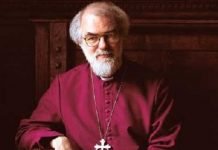A committee researching the possible reunification of the dioceses of Bethlehem and Central Pennsylvania released an in-depth summary of its work on Oct. 6, covering everything from the histories of the two dioceses, current staffing and financial considerations to shared ministry opportunities and the future role of the bishop.
The Reunification Discernment Committee expects to make final recommendations next year, in time for the two dioceses to take up the matter at their diocesan conventions in October 2024. Until then, the committee said, “we will offer further opportunities for regular communication, increased engagement and broader input across our dioceses as we consider models for further collaboration between dioceses, possible reunification and a timeline for transitions.”
The two dioceses’ conventions initiated this process in October 2022, when they approved “a period of intentional exploration” that could lead to “future reunification as one diocese.” Both dioceses originally were part of the Diocese of Pennsylvania, so a potential merger would follow the canonical process known as reunion. Pennsylvania was one of the church’s founding dioceses in 1785. Central Pennsylvania was split from the original diocese in 1870, and it further divided in 1905 to create what are now the dioceses of Central Pennsylvania and Bethlehem.
The dioceses have embarked on their current discernment at a time when The Episcopal Church, like most mainline Protestant denominations, has grappled with a long-term decline in membership and parishes have struggled to fill clergy positions in what is becoming an increasingly secular society.
“As Episcopalians, we have yet to fully acknowledge our current landscape and respond faithfully to it,” the Reunification Discernment Committee said in its report. “Could a reunification of our dioceses help foster such a response? Could the process of reunification help create a more sustainable and life-giving way forward for the Episcopal Church here?”
The dioceses’ discernment is part of a growing trend across The Episcopal Church of neighboring dioceses establishing both informal and formal partnerships, and some are taking steps to merge to reduce administrative costs while expanding ministry capabilities. The dioceses of Northwestern Pennsylvania and Western New York were an early model in 2018, when they finalized an agreement to collaborate and share a bishop while remaining separate entities.
The dioceses of Eastern Michigan and Western Michigan reached a similar agreement in 2019 and now are considering whether to pursue a process known as “juncture.” The dioceses will discuss their next steps at a joint convention later this month, setting up a possible spring vote on juncture, which then would need to be accepted by the 81st General Convention in June 2024.
Wisconsin’s three dioceses – Milwaukee, Fond du Lac and Eau Claire – are on track to finalize their own reunion next year. On Oct. 21, their diocesan conventions will vote on whether to empower the so-called Trialogue committee to draft a reunification agreement that would be voted on at a special convention in the spring and submitted to the 81st General Convention for final approval.
The Episcopal Church in North Texas, formerly the Diocese of Fort Worth, reunified with the Diocese of Texas in 2022 with votes of approval at the 80th General Convention, and the dioceses of Northern Indiana and Indianapolis are in the middle of their own discernment process about a possible reunification as one statewide diocese.
Other dioceses across the church are experimenting with their own partnership models. Bishops in the dioceses of Vermont, New Hampshire and Maine have agreed to assist each other across diocesan boundaries and explore other ways their dioceses can work together. In Pennsylvania, the bishops of all five Episcopal dioceses have coordinated their advocacy on the issue of gun violence, mirroring such efforts in the four Michigan dioceses. Likewise, the bishops of the three Episcopal dioceses in Tennessee came together last year on a joint statement advocating passage of a state constitutional amendment unequivocally outlawing slavery, with no exception made for criminal punishment.
Dioceses considering whether to merge often must first clear formidable hurdles, such as bridging cultural differences, fulfilling the canonical requirements and combining separate administrative operations and governance structures.
Read it all at ENS



